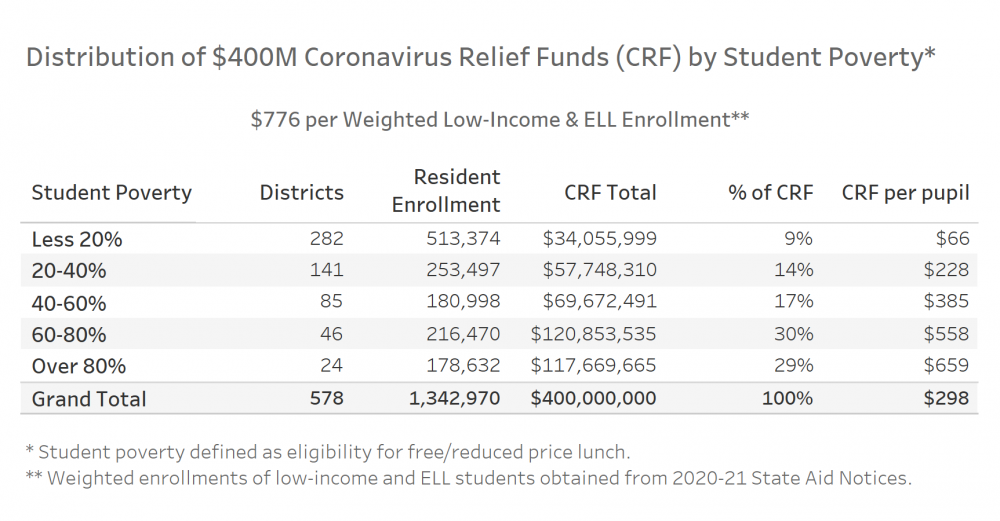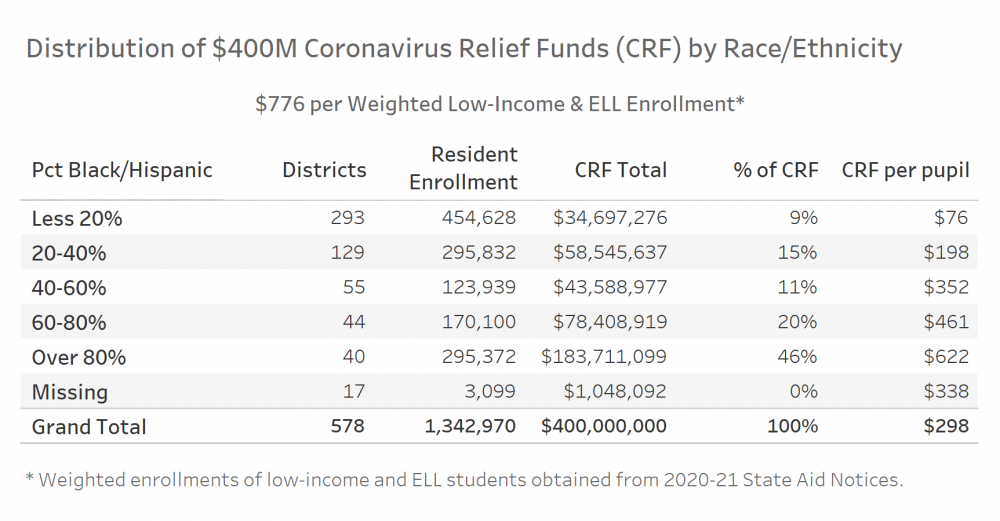TARGETING FEDERAL COVID-19 RELIEF FUNDS TO NJ DISTRICTS SEGREGATED BY POVERTY AND RACE
ELC Calls on All States to Drive More Federal Funds to High Need Districts
June 15, 2020
On May 22, Governor Phil Murphy made public a fiscal plan to revise New Jersey’s FY21 State Budget in light of projected revenue shortfalls resulting from the COVID-19 crisis. The Governor proposes to maintain school funding at current levels for the remainder of the 2019-20 school year, while eliminating a previously planned increase of $330 million in state aid for 2020-21.
Governor Murphy is also proposing that the Legislature set aside $400 million of New Jersey’s $2.4 billion allocation of federal Coronavirus Relief Funds (CRF) to support the state’s K-12 public schools in the 2020-21 school year. The CRF was allocated on a one–time basis by Congress in the Coronavirus Aid, Relief, and Economic Security Act (CARES Act) passed in late March.
Consistent with CARES Act requirements, the Governor proposes the federal CRF be used by school districts to support the additional costs of educating students by remote and digital means while schools remain closed and for re-opening schools when safe to do so.
In his fiscal plan, however, Governor Murphy did not propose nor offer any formula, method or mechanism for distributing the $400 million in CRF to New Jersey school districts.
COVID-19 has painfully exposed New Jersey’s crushing “digital divide” between poor, Black and Latino students, who are more often without the devices and/or internet connectivity needed for remote learning, and their more affluent peers across the state. For this reason, it is imperative that the Legislature distribute the lion’s share of CRF to districts most impacted by the digital divide, namely, districts segregated by poverty and race.
To accomplish this objective, Education Law Center is proposing the Legislature use the weighted enrollment counts of low-income students and English language learners (ELL) in the state’s school funding formula – the School Funding Reform Act (SFRA) – to distribute the federal CRF funds to districts. The “weights” in the SFRA formula represent the additional costs of educating low-income and ELL students while also accounting for the greater costs associated with concentrated poverty.
“By using each district’s unique weighted enrollment for these at-risk students, the State will distribute increasingly higher levels of CRF funds as the concentration of low-income and ELL students in the district increases,” said Dr. Danielle Farrie, ELC Research Director.
As the chart below shows, using the SFRA’s weighted low-income and ELL enrollments delivers higher levels of CRF funds to students in districts segregated by poverty. ELC calculates that the weighted method will allocate $659 per pupil in CRF funds to districts with 80% or more student poverty. These 24 districts, including Newark, Camden, and Passaic, account for 29% of all poor students statewide. The per pupil amounts gradually decrease as poverty concentration decreases, with the lowest poverty districts – those below 20% – receiving $66 per pupil.

The weighted enrollment method will also distribute higher levels of CRF funds to students in New Jersey’s most racially segregated districts. ELC calculates that the weighted method will allocate $622 per pupil to districts with 80% or more Black and Latino students. These 40 districts, including Trenton, Willingboro, and Lindenwold, educate 47% of all Black and Latino students statewide. The per pupil amounts gradually decrease so that districts with enrollments of less than 20% Black and Latino students receive $76 per pupil.

“We know the digital divide has disproportionately impacted the continuous learning opportunities of students in our state’s poorest, most racially isolated districts,” said David Sciarra, ELC Executive Director. “It is a matter of basic justice, fairness and equity for New Jersey lawmakers to make certain more federal funds reach those districts and students.”
The impact of school closure on students is not unique to New Jersey. Across the nation, districts serving high enrollments of poor students, recent immigrants, and students of color have the greatest and most urgent need for additional resources to maintain student learning remotely and to safely reopen schools. ELC’s recommendation that New Jersey distribute federal funds based on districts’ at-risk student populations is the approach every state should follow when allocating federal COVID-19 relief funds provided by the CARES Act or in subsequent federal relief legislation to local school districts. States must focus on the needs of their most vulnerable students when distributing federal funds to mitigate and address COVID-19 impacts on their public school systems.
View ELC’s proposed district-level allocations of CRF funds here.
Press Contact:
Sharon Krengel
Policy and Outreach Director
skrengel@edlawcenter.org
973-624-1815, x 24
Press Contact:
Sharon Krengel
Director of Policy, Strategic Partnerships and Communications
skrengel@edlawcenter.org
973-624-1815, x240